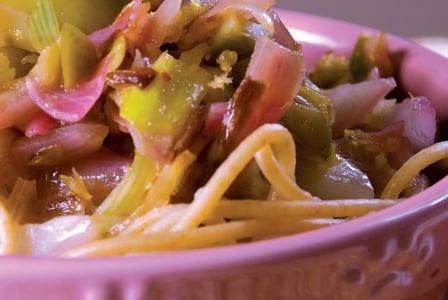
Pasta is versatile; it can be a main course, side dish, or a salad. As long as youre choosing whole grain pasta, its a great source of complex carbohydrates. Its easy to prepare; you can make a healthy dinner in about 15 minutes – just add the bells and whistles.
My roots are English, Scottish, and Irish. My mother’s idea of exotic Italian food was canned pasta. The orange sauce left a clown mouth ring around my lips for days. Luckily, my brother married a girl with German-Italian roots who introduced me to real pasta. I’ve been hooked ever since.
Pasta is versatile; it can be a main course, side dish, or a salad. As long as you’re choosing whole grain pasta, it’s a great source of complex carbohydrates. It’s easy to prepare; you can make a healthy dinner in about 15 minutes—just add the bells and whistles.
With spring upon us, try either of these pasta dishes to wake up your taste buds—bells and whistles included.
Recipes
- Pasta with Lemon Zest and Olives
- Asian Noodle Salad
Pasta portions
What the heck does 1/4 lb (125 g) of uncooked pasta look like? It’s one-third of a 375 g box of pasta.
Shallot servings
What does 1 cup (250 mL) of sliced shallots look like? It looks like a lot of shallots. Buy 10 small ones, 4 French shallots, or 2 large ones, and start slicing.
How do you cook pasta?
Use a large pot, a lot of water, and don’t add oil. Bring water to the boil, add pasta, and give it a stir to prevent it from sticking to the bottom of the pot. Bring it back to the boil, and then begin timing until it’s cooked al dente. Drain, but never rinse. Rinsing does two evil things: it removes valuable B vitamins as well as the starch that helps the sauce stick to the pasta.
What is al dente?
It basically means “to the tooth.” Translation: don’t cook the living daylights out of it. Pasta should have some kind of texture. Many people cook it until it’s mushy, which is a huge no-no. Read the package and follow the directions.
Feeling hungry?
How about snacking on some butterflies, pens, little worms, or little tongues? They’re also known as farfalle, penne, vermicelli, or linguine, respectively. There are over 600 different shapes of pasta, each with its own unique Italian name that describes its shape. Spaghetti means “little twines” in Italian—a perfect name for the long, stringy pasta.
Pasta shapes are grouped in general categories, such as shaped, tubular, strand, ribbon, or stuffed. Different shapes are complemented by different types of sauce. Shaped pasta such as farfalle, which looks like a butterfly or a bow-tie, can hold a thicker sauce. Thinner, more fragile pastas, such as capellini (angel hair) pasta, are best suited to thinner sauces that won’t overpower or weigh down the pasta.
Take some time to browse the pasta section of your local health food store, and you might be surprised at the options. There are plenty of pastas made from whole grains, kamut, spelt, brown rice, wild rice, corn, and buckwheat. Some of these are gluten free, and many have higher levels of fibre, vitamins, and minerals than white-flour pasta.
Storage tip: Cooked pasta can thicken and stick together after being refrigerated. If you have leftovers to save for the next day, add a dash of organic olive oil to the pasta and stir it in well before storing your pasta—it will help to prevent sticking.
—Amanda Lee

